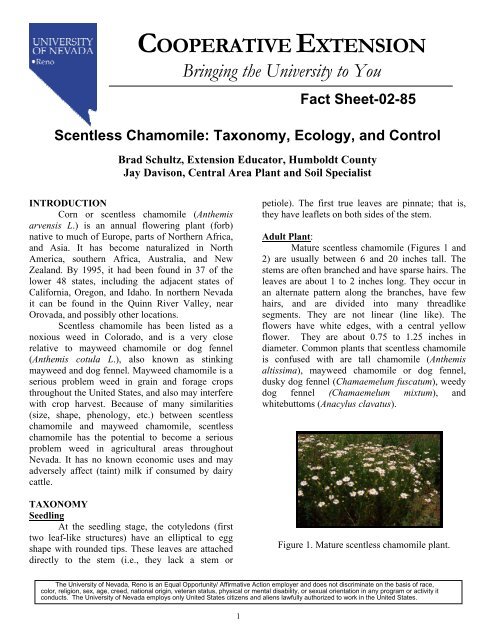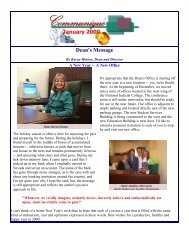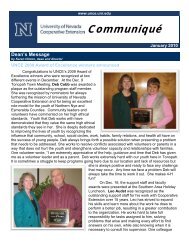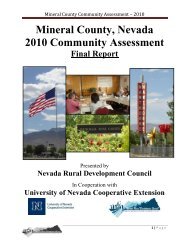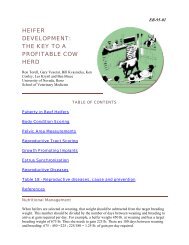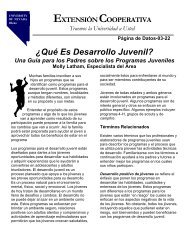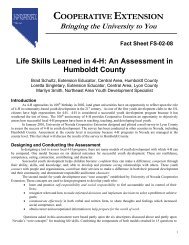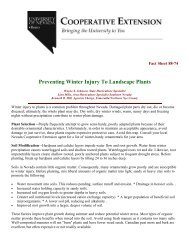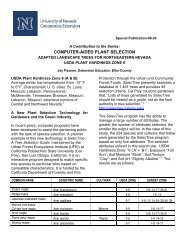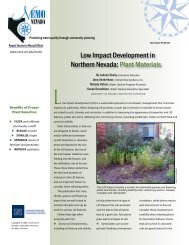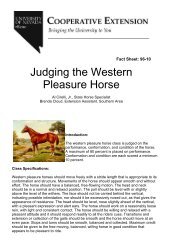Scentless Chamomile: Taxonomy, Ecology, and Control
Scentless Chamomile: Taxonomy, Ecology, and Control
Scentless Chamomile: Taxonomy, Ecology, and Control
You also want an ePaper? Increase the reach of your titles
YUMPU automatically turns print PDFs into web optimized ePapers that Google loves.
COOPERATIVE EXTENSION<br />
Bringing the University to You<br />
Fact Sheet-02-85<br />
<strong>Scentless</strong> <strong>Chamomile</strong>: <strong>Taxonomy</strong>, <strong>Ecology</strong>, <strong>and</strong> <strong>Control</strong><br />
Brad Schultz, Extension Educator, Humboldt County<br />
Jay Davison, Central Area Plant <strong>and</strong> Soil Specialist<br />
INTRODUCTION<br />
Corn or scentless chamomile (Anthemis<br />
arvensis L.) is an annual flowering plant (forb)<br />
native to much of Europe, parts of Northern Africa,<br />
<strong>and</strong> Asia. It has become naturalized in North<br />
America, southern Africa, Australia, <strong>and</strong> New<br />
Zeal<strong>and</strong>. By 1995, it had been found in 37 of the<br />
lower 48 states, including the adjacent states of<br />
California, Oregon, <strong>and</strong> Idaho. In northern Nevada<br />
it can be found in the Quinn River Valley, near<br />
Orovada, <strong>and</strong> possibly other locations.<br />
<strong>Scentless</strong> chamomile has been listed as a<br />
noxious weed in Colorado, <strong>and</strong> is a very close<br />
relative to mayweed chamomile or dog fennel<br />
(Anthemis cotula L.), also known as stinking<br />
mayweed <strong>and</strong> dog fennel. Mayweed chamomile is a<br />
serious problem weed in grain <strong>and</strong> forage crops<br />
throughout the United States, <strong>and</strong> also may interfere<br />
with crop harvest. Because of many similarities<br />
(size, shape, phenology, etc.) between scentless<br />
chamomile <strong>and</strong> mayweed chamomile, scentless<br />
chamomile has the potential to become a serious<br />
problem weed in agricultural areas throughout<br />
Nevada. It has no known economic uses <strong>and</strong> may<br />
adversely affect (taint) milk if consumed by dairy<br />
cattle.<br />
TAXONOMY<br />
Seedling<br />
At the seedling stage, the cotyledons (first<br />
two leaf-like structures) have an elliptical to egg<br />
shape with rounded tips. These leaves are attached<br />
directly to the stem (i.e., they lack a stem or<br />
petiole). The first true leaves are pinnate; that is,<br />
they have leaflets on both sides of the stem.<br />
Adult Plant:<br />
Mature scentless chamomile (Figures 1 <strong>and</strong><br />
2) are usually between 6 <strong>and</strong> 20 inches tall. The<br />
stems are often branched <strong>and</strong> have sparse hairs. The<br />
leaves are about 1 to 2 inches long. They occur in<br />
an alternate pattern along the branches, have few<br />
hairs, <strong>and</strong> are divided into many threadlike<br />
segments. They are not linear (line like). The<br />
flowers have white edges, with a central yellow<br />
flower. They are about 0.75 to 1.25 inches in<br />
diameter. Common plants that scentless chamomile<br />
is confused with are tall chamomile (Anthemis<br />
altissima), mayweed chamomile or dog fennel,<br />
dusky dog fennel (Chamaemelum fuscatum), weedy<br />
dog fennel (Chamaemelum mixtum), <strong>and</strong><br />
whitebuttoms (Anacylus clavatus).<br />
Figure 1. Mature scentless chamomile plant.<br />
The University of Nevada, Reno is an Equal Opportunity/ Affirmative Action employer <strong>and</strong> does not discriminate on the basis of race,<br />
color, religion, sex, age, creed, national origin, veteran status, physical or mental disability, or sexual orientation in any program or activity it<br />
conducts. The University of Nevada employs only United States citizens <strong>and</strong> aliens lawfully authorized to work in the United States.<br />
1
Figure 2. <strong>Scentless</strong> chamomile flowers<br />
PLANT GROWTH AND DEVELOPMENT<br />
In both Great Britain <strong>and</strong> the northeastern<br />
United States, scentless chamomile has two periods<br />
of peak germination: autumn <strong>and</strong> spring. If moisture<br />
is provided, seed germination is possible throughout<br />
the year. In Nevada, this species appears restricted<br />
to irrigated fields, storage ponds, <strong>and</strong> irrigation<br />
ditches. Irrigation in many locations is finished by<br />
early to mid September <strong>and</strong> fields dry rapidly. Fall<br />
germination <strong>and</strong> overwintering appear to be<br />
uncommon. All plants observed in the Orovada area<br />
begin growth in the spring.<br />
Spring germination largely occurs from<br />
March through May, with rapid plant growth in<br />
June. Flowering may begin in May <strong>and</strong> continue<br />
into the fall until the first frost. The first frost kills<br />
mature plants.<br />
SPECIES ECOLOGY<br />
Soils <strong>and</strong> Climate<br />
In Britain scentless chamomile prefers light,<br />
well drained calcareous or s<strong>and</strong>y soil. Similar type<br />
soils are common in agricultural fields near<br />
Orovada. Soil pH can range from less than 6 to<br />
almost 8. <strong>Scentless</strong> chamomile has been found<br />
above 3,300 ft in California, <strong>and</strong> over 6,200 ft in<br />
Engl<strong>and</strong>. In Engl<strong>and</strong>, scentless chamomile typically<br />
occurs in areas with less than 35 inches of<br />
precipitation <strong>and</strong> mean summer temperatures<br />
around 62°F. The average June <strong>and</strong> July<br />
temperatures in Orovada are 63°F <strong>and</strong> 71°F,<br />
respectively. These conditions are similar to<br />
irrigated agricultural fields in many valleys of<br />
northern Nevada.<br />
<strong>Scentless</strong> chamomile is cold tolerant. It has<br />
grown as a winter annual in the northeastern United<br />
States. It may germinate in the fall, over winter in a<br />
rosette form, <strong>and</strong> continue growth in the spring. Fall<br />
germination appears unlikely in Nevada due to the<br />
2<br />
lack of fall precipitation in most years. Also, most<br />
irrigation has ended by fall. Spring germination is<br />
common due to both rainfall <strong>and</strong> irrigation. Seed<br />
has been known to germinate year-round if moisture<br />
is available <strong>and</strong> temperatures are not too cold.<br />
<strong>Scentless</strong> chamomile is more drought tolerant than<br />
the other mayweed species, which suggests it has<br />
potential to spread to subirrigated meadows<br />
throughout Nevada.<br />
<strong>Scentless</strong> chamomile can grow well in low<br />
nitrogen (14 ppm) <strong>and</strong> low phosphorus (0.31 ppm)<br />
environments common on s<strong>and</strong>y soil. It can<br />
compete effectively with barley on low nitrogen<br />
environments.<br />
Seed Production, Dispersal, <strong>and</strong> Viability<br />
Reproduction of scentless chamomile is<br />
entirely from seed, <strong>and</strong> seed production can be quite<br />
large. Research has recorded over 300 seed capsules<br />
per plant, although 35 to 70 are more typical.<br />
Average size plants commonly produce 2,000 to<br />
4,000 seeds per plant. There are no physical<br />
adaptations for dispersal. Dispersal over short<br />
distances is primarily from wind. Dispersal over<br />
moderate distances appears related to the movement<br />
in irrigation water through delivery systems, <strong>and</strong><br />
possibly attachment to farm equipment or animals.<br />
Seed has been found to survive passage through the<br />
digestive system of pigeons; thus, birds could<br />
transport seed over long distances. Long distance<br />
dispersal occurs when seed is captured in forage <strong>and</strong><br />
seed crops during harvest, <strong>and</strong> transported to<br />
another area for use.<br />
The seed of scentless chamomile can remain<br />
alive for many years. Researchers found 91%<br />
germination in soil-stored seed after 3 years, <strong>and</strong><br />
47% germination after 11 years. Seed germination<br />
appears to increase substantially after the seed has<br />
been in the soil for a 4 to 10 month period. Also,<br />
one study found germination increased from 8% to<br />
100% after passage through the digestive tract of<br />
pigeons. <strong>Scentless</strong> chamomile seed has a tough seed<br />
coat that must be softened before germination can<br />
occur. Soil microorganisms, faunal digestive<br />
systems, <strong>and</strong> perhaps freeze thaw cycles, remove<br />
the seed coat.<br />
GROWING LOCATIONS<br />
In the Orovada area, dense st<strong>and</strong>s of<br />
scentless chamomile have been found along the
edges of roads <strong>and</strong> irrigated fields, <strong>and</strong> along<br />
irrigation ditches <strong>and</strong> tailwater ponds (Figure 3).<br />
Widely scattered plants have been observed in<br />
alfalfa seed, alfalfa hay, <strong>and</strong> grain crops. These are<br />
common locations for the plant in Great Britain,<br />
although it often has a high abundance in cereal<br />
crops.<br />
Figure 3. Typical habitat conditions for scentless<br />
chamomile at Orovada. White flowered plants are<br />
scentless chamomile.<br />
CONTROL<br />
Once scentless chamomile has established<br />
<strong>and</strong> produced seed at least once, eradication is<br />
almost impossible. The seed can live in the soil for<br />
more than 10 years <strong>and</strong> have about 50% viability.<br />
Given the high seed production per plant, this<br />
results in a large number of live seeds for many<br />
years after treatment begins. <strong>Control</strong> of the plant is<br />
a more realistic goal than eradication. Several<br />
control methods are possible <strong>and</strong> can be used in<br />
conjunction with one another.<br />
Numerous herbicides have been tested <strong>and</strong><br />
found to effectively control mayweeds, including<br />
scentless chamomile. These include: Roundup Pro,<br />
Telar, Tordon, Transline, Escort, Velpar, <strong>and</strong> Oracle<br />
(a dicamba product). Other herbicides may also be<br />
effective, but have not been tested specifically on<br />
scentless chamomile or the closely related<br />
mayweeds. <strong>Scentless</strong> chamomile is resistant to 2,4-<br />
D <strong>and</strong> other phenoxyacetic acid herbicides. If<br />
repeated herbicide applications are used, the<br />
applicator should alternate between chemicals to<br />
reduce the possibility of developing herbicide<br />
resistance.<br />
Each herbicide known to control scentless<br />
chamomile has very specific instructions on the<br />
product label. Some herbicides cannot be applied to<br />
each of the specific growing conditions in which<br />
scentless chamomile occurs (e.g., along irrigation<br />
ditches). The specific conditions under which each<br />
herbicide should be can be found on the product<br />
label. These labels can be accessed on the internet<br />
(Table 1).<br />
Table 1. Current Internet addresses for herbicide labels for products known to control mayweeds, including<br />
scentless chamomile.<br />
Herbicide Company Web Site Address for Label<br />
Escort DuPont http://www.dupont.com/ag/us/prodinfo/prodsearch/information/H63665.pdf<br />
Oracle<br />
(Dicamba)<br />
Gharda http://www.ghardausa.com/Pdf%20files/oracle_specbk_2001.pdf<br />
Roundup<br />
Pro<br />
Monsanto<br />
http://www.farmsource.com/Labels/RUPProCG.pdf<br />
Telar DuPont http://www.dupont.com/ag/us/prodinfo/prodsearch/information/H63735.pdf<br />
Tordon<br />
22K<br />
Dow<br />
Chemical<br />
http://www.dowagro.com/webapps/lit/litorder.asp?filepath=label/pdfs/noreg/010-<br />
00094.pdf&pdf=true<br />
Transline<br />
Dow<br />
Chemical<br />
http://www.dowagro.com/webapps/lit/litorder.asp?filepath=label/pdfs/noreg/010-<br />
00096.pdf&pdf=true<br />
Velpar DuPont http://www.dupont.com/ag/us/prodinfo/prodsearch/information/H64113.pdf<br />
3
Once herbicides reduce the density of large<br />
infestations, removal of remaining plants is feasible<br />
by mowing, hoeing, h<strong>and</strong> pulling, disking, or other<br />
methods. <strong>Scentless</strong> chamomile is an annual plant<br />
that reproduces only from seed. Removing the<br />
flowers before seed is set effectively eliminates<br />
future plants. Small infestations can be controlled<br />
easily by mowing or cutting the plants prior to seed<br />
set.<br />
Treated areas that lack desirable,<br />
competitive vegetation are susceptible to<br />
reinfestation. The area should be seeded to <strong>and</strong><br />
managed for an acceptable species, to competitively<br />
exclude scentless chamomile <strong>and</strong> other weeds.<br />
If scentless chamomile occurs on cropl<strong>and</strong><br />
<strong>and</strong> has viable seed when machinery is used in the<br />
field, the equipment should be washed afterwards. .<br />
This will reduce the chance of seed being moved<br />
from one area to another.<br />
Biological control has been researched in<br />
Canada but has not been found to control the plant<br />
by itself. The biological agent is a seed-head weevil<br />
(Omphalaplon hookeri). Research has found this<br />
species attacks up to 70% of the seed-heads, but<br />
over 170 seeds/head can still be produced, with<br />
55% viability of the seed.<br />
USDA Agricultural Research Service. 2002.<br />
Germplasm Resources Information Network<br />
(http://www.ars-grin.gov/cgibin/npgs/html/tax_search.pl?Anthemis+arvensis).<br />
National Plant Germplasm System.<br />
BIBLIOGRAPHY<br />
Bowes, G. B. 1999. <strong>Scentless</strong> <strong>Chamomile</strong> <strong>Control</strong><br />
on Roadsides. The Rural Councillor 34(10):1-4.<br />
Harris, P. <strong>and</strong> A. McClay. 2001. Omphalapion<br />
hookeri Kirby. Seed-head weevil .<br />
(http://res2.agr.ca/lethbridge/weedbio/agents/amo<br />
phook.htm). Lethbridge Research Centre, Alberta,<br />
Canada. 3 pp.<br />
Kay, Q. O. N. 1971. Bilolgical Flora of the British<br />
Isles. Anthemis arvensis L. Journal of <strong>Ecology</strong><br />
59:637-648.<br />
USDA Natural Resources Conservation Service.<br />
2002. Plants Profile. Anthemis arvensis L. Corn<br />
<strong>Chamomile</strong> The PLANTS database.<br />
(http://plants.usda.gov/cgi_bin/topics.cgi?earl=fac<br />
t_sheet.cgi). National Plant Data Center, Baton<br />
Rouge, LA. 708774<br />
4


